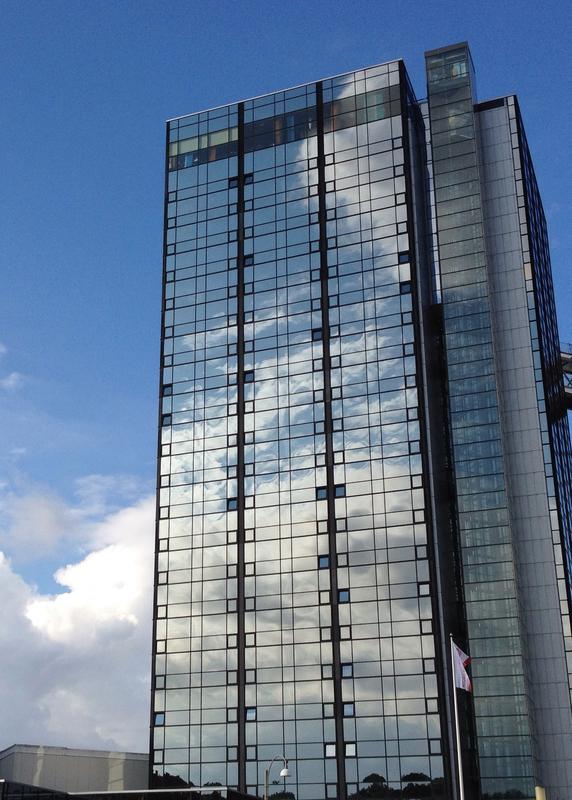Making window glass visible – but only to birds

Sky reflected in the windows of a high-rise building in central Gothenburg, Sweden. Photo: Anders Ödeen
Ultraviolet patterns can make window glass visible to birds, thus preventing fatal collisions. However, it has now been shown that such windows are not likely to work for all species, but only for birds like small passerines, gulls and parrots, who have a special type of colour vision. For birds of prey, geese, pigeons and crows, these patterns should be difficult to detect. These conclusions appear today in an article by Olle Håstad and Anders Ödeen in PeerJ.
Billions of birds are killed in window collisions every year. This is one of the most important human sources of avian mortality. A popular and effective remedy is to apply stickers showing the silhouettes of birds of prey to windows. Birds avoid colliding with these stickers but one problem remains: that the birds collide with the glass in between the stickers instead. To avoid having to cover whole windows with stickers, glass must be made visible to birds in some other, and less obtrusive, way.
As most birds can see ultraviolet light, which is invisible to humans, one solution is to mark the glass with ultraviolet reflective or absorbing patterns. Glass panes containing such ultraviolet absorbing patterns are currently commercially available. Elegant as this remedy may seem at first glance, field tests of UV-marked window panes have yielded mixed results. In a study published on October 9 in the open access journal PeerJ, Dr Olle Håstad at the Swedish University of Agricultural Sciences and Dr Anders Ödeen at Uppsala University show that ultraviolet window markings indeed have the potential to be effective deterrents. However, since birds differ strongly in how well they see ultraviolet light, the markings should only be visible to those bird species that have the right type of colour vision.
Håstad and Ödeen calculated how visible ultraviolet anti-collision markings are by using a physiological model of avian colour vision. They conclude that ultraviolet markings may be clearly visible under a range of lighting conditions, but only to birds with the so called UVS type of ultraviolet vision. Such birds include for example many small perching birds, gulls and parrots.
To species with the other (VS) type of colour vision, such as birds of prey, geese and ducks, pigeons and crows, ultraviolet markings should not be visible under most practical circumstances. To be visible to these birds, the patterns would have to produce virtually perfect contrasts and be viewed against a scene with low colour variation but a high ultraviolet content, such as a clear blue sky.
The article:
Olle Håstad & Anders Ödeen. 2014. A vision physiological estimation of ultraviolet window marking visibility to birds. PeerJ 2:e621.
Image: Sky reflected in the windows of a high-rise building in central Gothenburg, Sweden. Photo: Anders Ödeen
Press image (may be published without charge in articles about these findings, please acknowledge the photographer)
Contact:
Olle Håstad, PhD
Dept of Anatomy, Physiology and Biochemistry
Swedish University of Agricultural Sciences, Uppsala, Sweden
+46 (0)70 810 64 73, olle.hastad@slu.se
Pressofficer: David Stephansson: +46-725 11 69 90 or David.Stephansson@slu.se
https://peerj.com/articles/621/ article
Media Contact
All latest news from the category: Architecture and Construction
Newest articles

Trotting robots reveal emergence of animal gait transitions
A four-legged robot trained with machine learning by EPFL researchers has learned to avoid falls by spontaneously switching between walking, trotting, and pronking – a milestone for roboticists as well…

Innovation promises to prevent power pole-top fires
Engineers in Australia have found a new way to make power-pole insulators resistant to fire and electrical sparking, promising to prevent dangerous pole-top fires and reduce blackouts. Pole-top fires pose…

Possible alternative to antibiotics produced by bacteria
Antibacterial substance from staphylococci discovered with new mechanism of action against natural competitors. Many bacteria produce substances to gain an advantage over competitors in their highly competitive natural environment. Researchers…





















